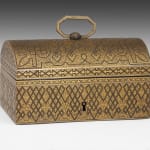Teodoro Ybarzabal of Eibar
Damascened Casket
SPAIN, CIRCA 1870, Stamped with signature on underside
10 x 18 x 11 cm
4 x 7 x 4 ¼ in
4 x 7 x 4 ¼ in
JL40
Further images
Provenance
Private Collection, Switzerland
Of rectangular form, decorated overall with geometric and scrolling decoration, the domed, hinged lid topped with a floral knop issuing a handle of elongated hexagonal form, key escutcheon to the...
Of rectangular form, decorated overall with geometric and scrolling decoration, the domed, hinged lid topped with a floral knop issuing a handle of elongated hexagonal form, key escutcheon to the front, with key, the lock with a two point mechanism.
Teodoro Ybarzabal had an engraving and damascene workshop in Eibar in the Basque region. Noted for his decoration to guns, he also made intricately decorated pieces such as boxes and candlesticks. Ybarzabal purchased, decorated and sold weapons and other items using his name as a brand. He was the protégé of Plácido Zuloaga (1834-1910). Zuloaga studied in Paris under Henri Lepage, gun-maker to Louis XVIII in 1848, and received a variety of royal commissions.
A damascened casket with a handle of similar form by Yrazabal was offered for sale at Bonhams, London, 12 July, 2023 estimated at £6,000-£8,000 (lot 86).
Some of the finest examples of damascened metalwork, including a number of examples by Zuloaga and from Eibar, can be found in the Khalili Collections (https://www.khalilicollections.org/all-collections/spanish-damascene-metalwork/)
Damascening: is the practice of inlaying different metals into one another to create elaborate patterns. Typically, gold or silver are inlaid into a backdrop of deeply oxidised steel. This technique saw a resurgence in Spain in the late 19th century. The perceived similarity to the elaborate tapestry patterns of damask silk is the source of the English word. Cities with a long history of damascening and where the art is still practiced include Kyoto in Japan, Malaysia, Indonesia, Toledo in Spain and Eibar in the Basque region.
Teodoro Ybarzabal had an engraving and damascene workshop in Eibar in the Basque region. Noted for his decoration to guns, he also made intricately decorated pieces such as boxes and candlesticks. Ybarzabal purchased, decorated and sold weapons and other items using his name as a brand. He was the protégé of Plácido Zuloaga (1834-1910). Zuloaga studied in Paris under Henri Lepage, gun-maker to Louis XVIII in 1848, and received a variety of royal commissions.
A damascened casket with a handle of similar form by Yrazabal was offered for sale at Bonhams, London, 12 July, 2023 estimated at £6,000-£8,000 (lot 86).
Some of the finest examples of damascened metalwork, including a number of examples by Zuloaga and from Eibar, can be found in the Khalili Collections (https://www.khalilicollections.org/all-collections/spanish-damascene-metalwork/)
Damascening: is the practice of inlaying different metals into one another to create elaborate patterns. Typically, gold or silver are inlaid into a backdrop of deeply oxidised steel. This technique saw a resurgence in Spain in the late 19th century. The perceived similarity to the elaborate tapestry patterns of damask silk is the source of the English word. Cities with a long history of damascening and where the art is still practiced include Kyoto in Japan, Malaysia, Indonesia, Toledo in Spain and Eibar in the Basque region.








